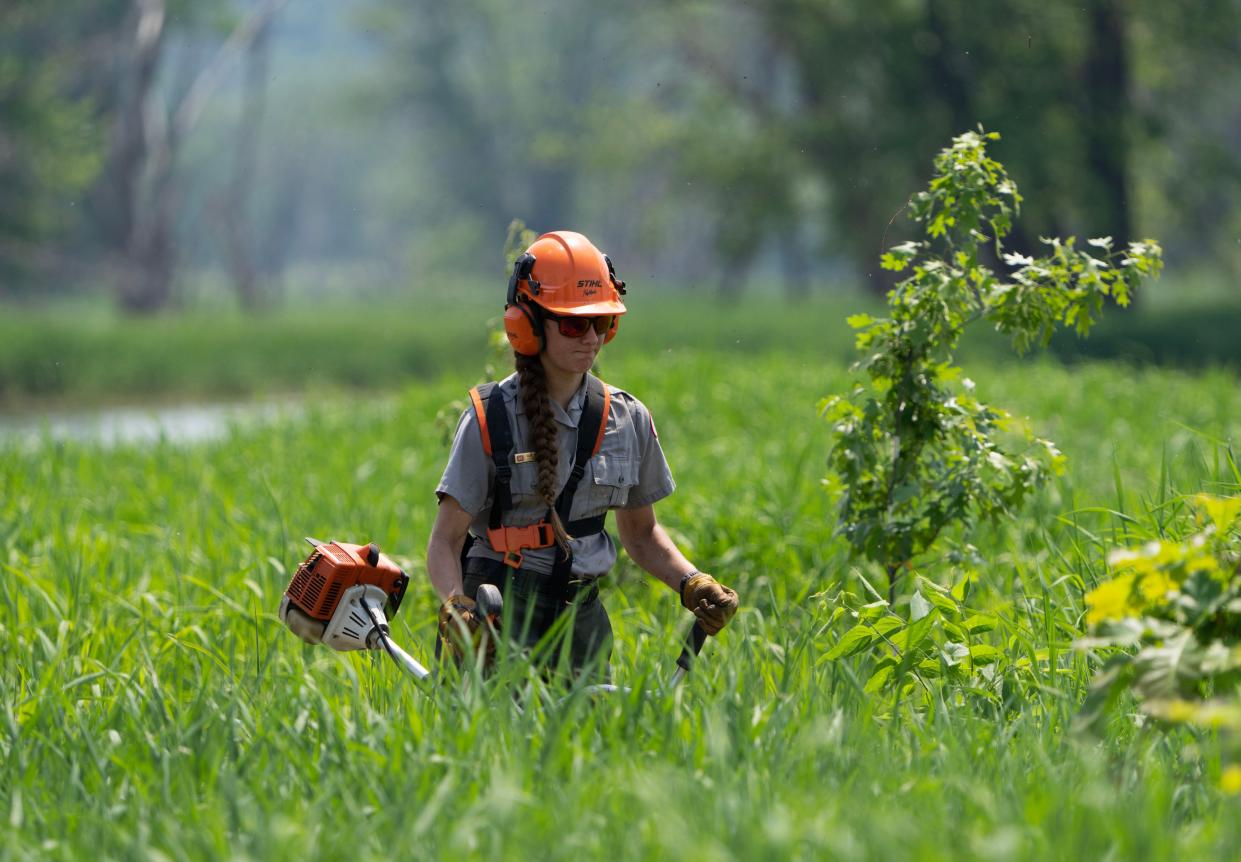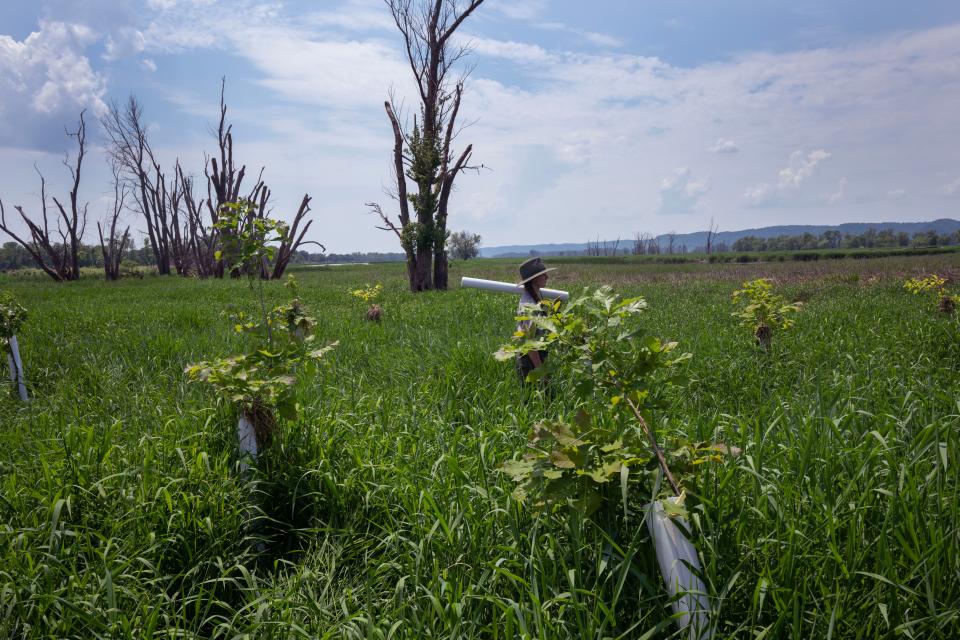What to know about the aggressive grass taking over forests along the upper Mississippi River

As the temperature neared 90 on a day in early June, Sara Rother revved up a weed-whacker and began to cut down the waist-high grass that blanketed the small island she stood on in the Mississippi River.
Rother, a forester with the U.S. Army Corps of Engineers, was clearing away reed canary grass — an aggressive plant species that has invaded the forests and wetlands along the upper Mississippi. This unnamed island, just south of La Crosse, used to be forest-covered. Only a few trees remain, some of them dead, providing scant relief from the hot sun.
Fellow forester Andy Meier equates the arrival of reed canary grass to cancer. A patch of forest might look healthy today, but when tree diseases and excess water cause big trees to die, the grass is waiting in the wings when the canopy opens up. Sun-loving and fast-growing, it moves in quickly, eating up the resources that young trees would usually use to grow and eventually taking over.
Forests along the Mississippi River are already being degraded, and in the northern parts of the floodplain, reed canary grass is one of the heaviest influences on their struggle, said Lyle Guyon, a terrestrial ecologist at the National Great Rivers Research and Education Center.
Losing forest — which provides critical wildlife habitat, stabilizes the soil and improves water quality — to a troublesome grass won't be good for the ecosystem. Land managers want to slow down its growth, but the grass is unlikely to get eradicated completely.
So what now?
What is reed canary grass?
Reed canary grass is a perennial grass that grows in dense mats that can reach up to nine feet tall. It loves light, and moist fertile soil, growing most often in wetlands, ditches and soggy fields. The grass has a thick root layer that prevents other plants from establishing in the ground.
It's an invasive species, meaning it was introduced into the ecosystem and is now causing harm. Reed canary grass easily outcompetes other vegetation and is often the first plant to grow in an area that has experienced some sort of disturbance, according to the Wisconsin Wetlands Association.
On the upper Mississippi River, for example, tree die-offs from disease and flooding have allowed the grass to get a stronger foothold.
"The species is sort of there, ready to capitalize on increased tree mortality," said Nathan De Jager, who researches the upper river’s floodplain forests for the U.S. Geological Survey.
More: The Mississippi River's floodplain forests are dying. The race is on to bring them back.
Where did it come from?
Before the locks and dams were installed to control the flows of the upper Mississippi, much of the land near the river was used for agriculture. Farmers planted reed canary grass for their livestock to forage.
Some reed canary grass is native to North America. Other types were introduced from Europe and Asia.

Why is it a problem?
There are several things a forest can do for the river that a patch of reed canary grass can't.
When flooding happens, the deep roots of big trees slow down water and capture sediment. But water flows right over the top of reed canary grass, Meier said. Trees also stabilize the soil and prevent erosion. More erosion has occurred on islands that are dominated by reed canary grass, he said.
Soils along the river also contain a lot of nitrogen. Reed canary grass may leach more of that nitrogen into the river because it can't hold onto it as long as trees do.
An ecosystem covered with reed canary grass would allow more nitrogen to seep into the river than a forested one, De Jager said — "and it's already a really high-nitrogen river." That nitrogen, of course, ends up in the Gulf of Mexico, where it creates the Dead Zone, a massive hypoxic area that chokes off aquatic life.
How widespread is it?
The U.S. Geological Society has done some work mapping where the grass occurs on the river floodplain between Minneapolis and central Iowa, using data from 2010, De Jager said. Along the river between Onalaska and Genoa, Wisconsin, for example, reed canary grass was found in 80% of the forest understory that was surveyed. Further north, between Hager City and Alma, Wisconsin, it was found in 70% of the surveyed understory.
They also looked at how much the grass had taken over meadows. It made up 70% of all the meadow area surveyed along the entire stretch of upper river. Near La Crosse, it made up as much as 90%.
Scientists know that in some places, reed canary grass has completely taken over an area that used to be forested. They don't know yet whether that change will be permanent, De Jager said.
Further downriver, this species is less of a problem — but there are other invasive plants to contend with. Japanese hops, Johnsongrass and Chinese tallow are all causing problems in the river floodplain.
More: These 5 invasive insects pose the biggest threats to Wisconsin trees, experts say
What can be done to stop it?
One organization invested in clearing it up is Audubon's regional office that covers Minnesota, Iowa and Missouri. The group views the ceding of floodplain forest to grass as a threat to the Mississippi Flyway, through which more than 325 bird species journey each year to and from their wintering grounds. Those birds use trees for shelter and for food.
"We have no delusions that we will eradicate (reed canary grass) from the river," said Dale Gentry, director of conservation for the region.
But they're going to try to slow it down.
They've tried a few strategies, building on work from other agencies also trying to curb it, like the U.S. Fish and Wildlife Service and the Army Corps. Planting thousands of young trees and revisiting those areas to manage the grass around them is less costly, but more time consuming. Planting three-year-old trees, which already are tall enough to beat out the grass for sunlight, has yielded a higher survival rate but is more expensive.
There's also the tactic of killing off reed canary grass entirely by burning it, mowing it or using herbicides. It won't be gone for long, but if the timing is right and nearby trees drop seed onto the bare ground left behind, it makes natural regeneration possible.
Gentry said they focus their work on stretches of floodplain forest that are at a higher elevation, so new trees have less chance of being wiped out by floodwaters. They also identify places where they can connect patches of habitat, making it more continuous for wildlife to move through.
The ultimate goal: If a canopy of trees covers the grass, it'll start to go away on its own. It doesn't like shade.
"We want people to understand the importance of the river to birds and why we are so invested in this area," Gentry said. "It's worth taking on."
Madeline Heim is a Report for America corps reporter who writes about environmental issues in the Mississippi River watershed and across Wisconsin. Contact her at 920-996-7266 or mheim@gannett.com.
Please consider supporting journalism that informs our democracy with a tax-deductible gift to this reporting effort at jsonline.com/RFA or by check made out to The GroundTruth Project with subject line Report for America Milwaukee Journal Sentinel Campaign. Address: The GroundTruth Project, Lockbox Services, 9450 SW Gemini Dr, PMB 46837, Beaverton, Oregon 97008-7105.
This article originally appeared on Milwaukee Journal Sentinel: Reed canary grass invades Mississippi River floodplain forests


